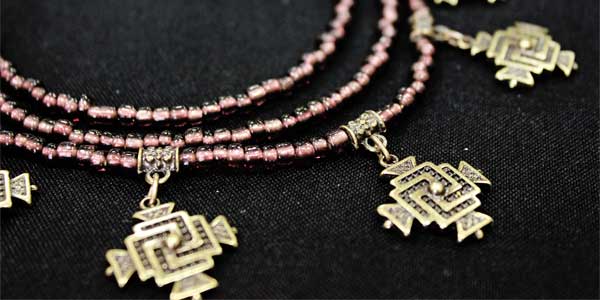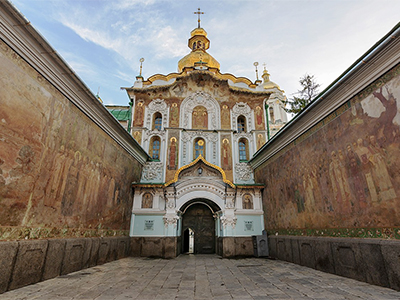 19.04.2018
Hutsul Zgarda
19.04.2018
Hutsul ZgardaZgarda is an amulet in a specific form of crosses. Zgarda is a pre-Christian amulet, and church had a disapproving attitude to it. Therefore, women wore zgarda as pectorals, in several lines to avoid suspicious. Men wore zgarda as rings.
Similar to other types of Hutsuls’ folk art the ornamentation of Hutsulian jewelry had the elements of ancient pre-Christian culture. Here in the inaccessible Carpathians the traditions of Old Slavonic art had been preserved till the twentieth century. The source of ornamental compositions on the Hutsulian jewelry was ancient Slavic solar cult that song praises to primitive farming and cattle breeding, where life-giving power of sun was considered as a decisive factor. A symbol of sun became an emblem of wealth and prosperity, and for the population of the Ukrainian Carpathians, who to this day has kept a lot of magical beliefs, this symbol was widely used as an amulet at that time. That’s why the Hutsulian masters so often used different varieties of the solar symbol in decorating jewelry. With time solar signs gradually were improved, acquired different attributes, appeared in different combinations with other images. Folk art of Hutsulshchyna existed for centuries; it lived and developed, created new forms that reflected the new meaning of life.
The Hutsulian ornamentation of jewelry reflected particularly the period of ancient Russia with characteristics of Christianization process and struggle against paganism. This process wasn’t unexpected. It lasted for a long time and was clearly reflected in the folk art by gradual assimilation of the old pagan symbolism with new Christian one. Christianity could enter into masses by only adapting its conceptions, its images to the pagan conceptions and images which were kept by people.
Firstly, solar symbolism was undergone by assimilation, expressed in confluence of solar disc and cross – the main emblem of Christian cult.
This process is most clearly seen in the Hutsulian metal pectorals – Zgarda, consisting of one or two (rarely more) lines of discs or crosses. To connect zgarda so called “chepraga” are used – two (mostly round) plates, decorated with chased or openwork ornament.
When you look at zgarda at first sight, you see some disproportion in size of chepraga and zgarda. Chepraga has usually big unreasonable dimensions. Some of them are 6-7 centimeters in diameter, indicating their special place among necklaces. Chepraga – a solar symbol – was designed to protect people from evil spirits. In most cases different variations of solar symbolism were placed in the central part of chepraga such as a wheel with eight, six or four spokes, concentric circles, etc.
The archaic type of zgarda played the same role, consisting of round, sun-like medallions, similar to chepraga, decorated with six-petalled rosette or other similar solar emblems. The peculiar feature of such zgarda is placing equilateral cross with four small circles in the circles of discs. These cross-shaped elements with pre-Christian origin were solar signs.
Bur gradually, step by step, these disk-like solar signs of zgarda became cross-shaped. Sun-like discs in zgarda were replaced by crosses with equal branches with gaps between them filled with rays. Crosses had in general the same shapes and dimensions. Subsequently crosses lost their sameness: one of the branches became longer and the cross gained the features of specific Christian cult. An embossed crucifix with features of primitive sculpture appeared on the crosses of this type. But even these Christian crosses had many remainders of pagan symbolism. Thus, at the ends of these crosses’ branches sometimes we can see solar rosettes or circles. Such crosses were used as part of zgarda and self-adornment. Men mostly wore them (rarely women) on the chains. According to the execution chains had such forms: round, flat, oblong wicker, entwined.
A separate group of Hutsulian jewelry is rings and wedding rings, cast from brass, bronze and white copper.
In Hutsulshchyna two types of rings existed: rings for wearing on the hands and rings for connecting neckerchiefs which girls presented the boys. In both cases they are related to the idea of marriage. Their ornaments have rich symbolic meaning with ideas of continuity of life, procreation, protection of family hearth.
The outer surface of wedding ring was decorated with embossed or engraved ornament. The latter usually consisted of a pair of rhombuses with solar crosses or solar circles. Sometimes these solar signs are connected in one figure. Based on the ritual purpose of rings, such images are believed to symbolize the married couple.
In other cases two more circles are added between rhombuses to two circles that are inside the rhomb. This ornamental scheme was widely used in the decoration of Hutsulian jewelry as a variant of solar cross. There is a hypothesis that this sign is a symbol of newly built house. In this case the image is identical to the marriage idea of newlywed’s farming. This trimming technique of rings is firmly kept in the modern Hutsulian wares.
This ornamental element is often found on the rings in the form of circle. Rings with a round shield were decorated by the ornament which repeated the solar elements of chepraga: six-petalled rosette, solar crosses, concentric rings, rays, etc. The ornament was engraved and supplemented by color putty, imitating enamel.
Hutsuls’ folk culture was aptly characterized by M. Kotsiubynskyi: “Hutsuls are original people with a rich imagination and a peculiar mentality. Being a deep pagan, Hutsuls spend their entire lives in the fight against evil spirits, inhabiting forests, mountains and waters. They used Christianity only to decorate a pagan cult.
That’s why wedding rings, rings, as well as other kinds of adornments, with their inherent archaic features were in popular demand among mountaineers. They were integral attributes of holiday and wedding clothes. Therefore, craftsmen of Hutsulshchyna made these adornments with great love, putting their creative imagination into them. The Hutsulian adornments are great examples of folk art that show huge artistic abilities of folk masters at Hutsulshchyna. A great proof of these words is the collection at Y. Kobrynskyi Kolomyya Museum of Folk Art of Hutsulshchyna where large amounts of various kinds of Hutsulian adornments are preserved, starting from the seventeenth century”.
-
 27.02.2024
World of pysanka
Embark on a journey into the captivating world of Pysanka, the Ukrainian...
27.02.2024
World of pysanka
Embark on a journey into the captivating world of Pysanka, the Ukrainian...
-
 29.01.2024
Exploring the Treasures of Kyiv’s Lavra Monastery
In the heart of Kyiv lies the venerable Lavra Monastery, a testament...
29.01.2024
Exploring the Treasures of Kyiv’s Lavra Monastery
In the heart of Kyiv lies the venerable Lavra Monastery, a testament...
-
 13.01.2024
Kachanivka, Eden on Earth
Rich in history, it hosted renowned artists, notably poet Taras Shevchenko.
13.01.2024
Kachanivka, Eden on Earth
Rich in history, it hosted renowned artists, notably poet Taras Shevchenko.

